Response of Runoff to Extreme Land Use Change in the Permafrost Region of Northeastern China
Abstract
:1. Introduction
2. Materials and Methods
2.1. Study Area
2.2. Data Collection
2.3. Model Construction and Validation
2.3.1. Model Theory and Scenario Construction
2.3.2. Model Setup and Validation
3. Results
3.1. Calibration and Validation of the Streamflow
3.2. Analysis of LUCC and Its Impacts on Runoff in the Tahe River Basin
3.2.1. Characteristics of LUCC
3.2.2. Response of Runoff to LUCC
3.3. Construction of Different Land-Use Scenarios and Their Impacts on Runoff
3.3.1. Simulation of the Impacts of Extreme Land-Use Scenarios on Runoff
3.3.2. Construction of Future Scenarios and Their Impacts on Runoff
4. Discussion
4.1. Impacts of LUCC on Runoff
4.2. Response of Runoff under Extreme Land-Use Scenarios
4.3. Limitations of the SWAT Model and Future Research Prospects
5. Conclusions
Author Contributions
Funding
Acknowledgments
Conflicts of Interest
References
- Ma, K.; Huang, X.; Guo, B.; Wang, Y.; Gao, L. Land Use/Land Cover Changes and Its Response to Hydrological Characteristics in the Upper Reaches of Minjiang River. Proc. Int. Assoc. Hydrol. Sci. 2018, 379, 243–248. [Google Scholar] [CrossRef]
- Saliba, L.J. Coastal land use and environmental problems in the Mediterranean. Land Use Policy 1990, 7, 217–230. [Google Scholar] [CrossRef]
- Paulo, R.F.C.; Adauto, L.C.; Gustavo, B.Z.; de Carvalho, M.M. Integrated Management of Water Resources and Land Use in Urban- Metropolitan Basins: Flood Control in the Iguau-Sarapu River Basin (Rio De Janeiro, Brazil). Resour. Environ. 2012, 2, 56–66. [Google Scholar]
- Nian, Y.; Li, X.; Zhou, J.; Hu, X. Impact of land use change on water resource allocation in the middle reaches of the Heihe River Basin in northwestern China. J. Arid. Land 2013, 6, 273–286. [Google Scholar] [CrossRef] [Green Version]
- Li, H.; Liu, G.; Fu, B. Estimation of regional evapotranspiration in alpine area and its response to land use change: A case study in Three-River Headwaters region of Qinghai-Tibet Plateau, China. Chin. Geogr. Sci. 2012, 22, 437–449. [Google Scholar] [CrossRef]
- Li, M.; Chu, R.; Islam, A.R.M.T.; Shen, S. Characteristics of surface evapotranspiration and its response to climate and land use and land cover in the Huai River Basin of eastern China. Environ. Sci. Pollut. Res. 2021, 28, 683–699. [Google Scholar] [CrossRef]
- Nie, W.; Yuan, Y.; Kepner, W.; Nash, M.S.; Jackson, M.; Erickson, C. Assessing impacts of Landuse and Landcover changes on hydrology for the upper San Pedro watershed. J. Hydrol. 2011, 407, 105–114. [Google Scholar] [CrossRef]
- Ghaffari, G.; Keesstra, S.; Ghodousi, J.; Ahmadi, H. SWAT-simulated hydrological impact of land-use change in the Zanjanrood basin, Northwest Iran. Hydrol. Process. 2010, 24, 892–903. [Google Scholar] [CrossRef]
- Zhou, G.; Wei, X.; Luo, Y.; Zhang, M.; Li, Y.; Qiao, Y.; Liu, H.; Wang, C. Forest recovery and river discharge at the regional scale of Guangdong Province, China. Water Resour. Res. 2010, 46, 9503. [Google Scholar] [CrossRef] [Green Version]
- Hubbart, J.A.; Kellner, E.; Zeiger, S.J. A Case-Study Application of the Experimental Watershed Study Design to Advance Adaptive Management of Contemporary Watersheds. Water 2019, 11, 2355. [Google Scholar] [CrossRef] [Green Version]
- Aryal, Y.; Zhu, J. Effect of watershed disturbance on seasonal hydrological drought: An improved double mass curve (IDMC) technique. J. Hydrol. 2020, 585, 124746. [Google Scholar] [CrossRef]
- Kiprotich, P.; Wei, X.; Zhang, Z.; Ngigi, T.; Qiu, F.; Wang, L. Assessing the Impact of Land Use and Climate Change on Surface Runoff Response Using Gridded Observations and SWAT+. Hydrology 2021, 8, 48. [Google Scholar] [CrossRef]
- Gassman, P.W.; Reyes, M.R.; Green, C.H.; Arnold, J.G. The Soil and Water Assessment Tool: Historical Development, Applications, and Future Research Directions. Trans. ASABE 2007, 50, 1211–1250. [Google Scholar] [CrossRef] [Green Version]
- Anand, J.; Gosain, A.; Khosa, R. Prediction of land use changes based on Land Change Modeler and attribution of changes in the water balance of Ganga basin to land use change using the SWAT model. Sci. Total. Environ. 2018, 644, 503–519. [Google Scholar] [CrossRef] [PubMed]
- Liu, J.; Zhang, C.; Kou, L.; Zhou, Q. Effects of Climate and Land Use Changes on Water Resources in the Taoer River. Adv. Meteorol. 2017, 2017, 1–13. [Google Scholar] [CrossRef] [Green Version]
- Wang, Q.; Xu, Y.; Xu, Y.; Wu, L.; Wang, Y.; Han, L. Spatial hydrological responses to land use and land cover changes in a typical catchment of the Yangtze River Delta region. Catena 2018, 170, 305–315. [Google Scholar] [CrossRef]
- Walvoord, M.A.; Kurylyk, B.L. Hydrologic Impacts of Thawing Permafrost-A Review. Vadose Zone J. 2016, 15, 1–20. [Google Scholar] [CrossRef]
- Duan, L.; Man, X.; Kurylyk, B.; Cai, T.; Li, Q. Distinguishing streamflow trends caused by changes in climate, forest cover, and permafrost in a large watershed in northeastern China. Hydrol. Process. 2017, 31, 1938–1951. [Google Scholar] [CrossRef]
- Connon, R.F.; Quinton, W.L.; Craig, J.; Hayashi, M. Changing hydrologic connectivity due to permafrost thaw in the lower Liard River valley, NWT, Canada. Hydrol. Process. 2014, 28, 4163–4178. [Google Scholar] [CrossRef]
- Lingxue, Y.U.; Shuwen, Z.; Tingxiang, L.; Junmei, T.; Kun, B.U.; Jiuchun, Y. Spatio-temporal Pattern and Spatial Heterogeneity of Ecotones Based oh Land Use Types of Southeastern da Hinggan Mountains in China. Chin. Geogr. Sci. 2015, 25, 184–197. [Google Scholar]
- Xia, T.; Wu, W.; Zhou, Q.; Verburg, P.H.; Yu, Q.; Yang, P.; Ye, L. Model-based analysis of spatio-temporal changes in land use in Northeast China. J. Geogr. Sci. 2015, 26, 171–187. [Google Scholar] [CrossRef]
- Beck, I.; Ludwig, R.; Bernier, M.; Lévesque, E.; Boike, J. Assessing Permafrost Degradation and Land Cover Changes (1986-2009) using Remote Sensing Data over Umiujaq, Sub-Arctic Québec. Permafr. Periglac. Process. 2015, 26, 129–141. [Google Scholar] [CrossRef] [Green Version]
- Baltzer, J.L.; Veness, T.; Chasmer, L.E.; Sniderhan, A.E.; Quinton, W.L. Forests on thawing permafrost: Fragmentation, edge effects, and net forest loss. Glob. Chang. Biol. 2014, 20, 824–834. [Google Scholar] [CrossRef]
- Yu, Z.; Sun, G.; Cai, T.; Hallema, D.W.; Duan, L. Water Yield Responses to Gradual Changes in Forest Structure and Species Composition in a Subboreal Watershed in Northeastern China. Forests 2019, 10, 211. [Google Scholar] [CrossRef] [Green Version]
- Yu, Z.; Man, X.; Duan, L.; Cai, T. Assessments of Impacts of Climate and Forest Change on Water Resources Using SWAT Model in a Subboreal Watershed in Northern da Hinggan Mountains. Water 2020, 12, 1565. [Google Scholar] [CrossRef]
- Jin, H.; Sun, G.; Yu, S.; Jin, R.; He, R. Symbiosis of marshes and permafrost in Da and Xiao Hinggan Mountains in northeastern China. Chin. Geogr. Sci. 2008, 18, 62–69. [Google Scholar] [CrossRef]
- Jiyuan, L.; Mingliang, L.; Xiangzheng, D.; Dafang, Z.; Zengxiang, Z.; Di, L. The land use and land cover change database and its relative studies in China. J. Geogr. Sci. 2002, 12, 275–282. [Google Scholar] [CrossRef]
- Zhao, W.J.; Sun, W.; Li, Z.L.; Fan, Y.W.; Song, J.S.; Wang, L.R. A Review on SWAT Model for Stream Flow Simulation. Adv. Mater. Res. 2013, 726-731, 3792–3798. [Google Scholar] [CrossRef]
- Duan, L.; Cai, T. Quantifying Impacts of Forest Recovery on Water Yield in Two Large Watersheds in the Cold Region of Northeast China. Forrsts 2018, 9, 392. [Google Scholar] [CrossRef] [Green Version]
- Zhang, Y.; Guan, D.; Jin, C.; Wang, A.; Wu, J.; Yuan, F. Impacts of climate change and land use change on runoff of forest catchment in northeast China. Hydrol. Process. 2012, 28, 186–196. [Google Scholar] [CrossRef]
- Stone, L.E.; Fang, X.; Haynes, K.M.; Helbig, M.; Pomeroy, J.W.; Sonnentag, O.; Quinton, W.L. Modelling the effects of permafrost loss on discharge from a wetland-dominated, discontinuous permafrost basin. Hydrol. Process. 2019, 33, 2607–2626. [Google Scholar] [CrossRef]
- Jin, H.; Yu, Q.; Lü, L.; Guo, D.; He, R.; Yu, S.; Sun, G.; Li, Y. Degradation of permafrost in the Xing’anling Mountains, northeastern China. Permafr. Periglac. Process. 2007, 18, 245–258. [Google Scholar] [CrossRef]
- Ding, Y.; Ren, G.; Zhao, Z.; Xu, Y.; Luo, Y.; Li, Q.; Zhang, J. Detection, causes and projection of climate change over China: An overview of recent progress. Adv. Atmos. Sci. 2007, 24, 954–971. [Google Scholar] [CrossRef]
- Ma, X.; Xu, J.; Luo, Y.; Aggarwal, S.P.; Li, J. Response of hydrological processes to land-cover and climate changes in Kejie watershed, south-west China. Hydrol. Process. 2009, 23, 1179–1191. [Google Scholar] [CrossRef]
- Malagò, A.; Pagliero, L.; Bouraoui, F.; Franchini, M. Comparing calibrated parameter sets of the SWAT model for the Scandinavian and Iberian peninsulas. Hydrol. Sci. J. 2015, 60, 1–19. [Google Scholar] [CrossRef] [Green Version]
- Fu, Q.; Shi, R.; Li, T.; Sun, Y.; Liu, N.; Cui, S.; Hou, R. Effects of land-use change and climate variability on streamflow in the Woken River basin in Northeast China. River Res. Appl. 2019, 35, 121–132. [Google Scholar] [CrossRef]
- Arnold, J.G.; Moriasi, D.N.; Gassman, P.W.; Abbaspour, K.C.; White, M.J.; Srinivasan, R.; Santhi, C.; Harmel, R.D.; van Griensven, A.; Van Liew, M.W.; et al. SWAT: Model Use, Calibration, and Validation. Trans. ASABE 2012, 55, 1491–1508. [Google Scholar] [CrossRef]
- Guo, J.; Su, X. Parameter sensitivity analysis of SWAT model for streamflow simulation with multisource precipitation datasets. Hydrol. Res. 2019, 50, 861–877. [Google Scholar] [CrossRef] [Green Version]
- Moriasi, D.; Gitau, M. Hydrologic and Water Quality Models: Performance Measures and Evaluation Criteria. Trans. ASABE 2015, 58, 1763–1785. [Google Scholar] [CrossRef] [Green Version]
- Weber, A.; Fohrer, N.; Möller, D. Long-term land use changes in a mesoscale watershed due to socio-economic factors—Effects on landscape structures and functions. Ecol. Model. 2001, 140, 125–140. [Google Scholar] [CrossRef]
- Li, Q.; Wei, X.; Zhang, M.; Liu, W.; Fan, H.; Zhou, G.; Giles-Hansen, K.; Liu, S.; Wang, Y. Forest cover change and water yield in large forested watersheds: A global synthetic assessment. Ecohydrology 2017, 10, e1838. [Google Scholar] [CrossRef]
- Alibuyog, N.R.; Ella, V.B.; Reyes, M.R.; Srinivasan, R.; Dillaha, T. Predicting the effects of land use change on runoff and sediment yield in manupali river subwatersheds using the SWAT model. Int. Agric. Eng. J. 2009, 18, 15. [Google Scholar]
- Robitu, M.; Musy, M.; Inard, C.; Groleau, D. Modeling the influence of vegetation and water pond on urban microclimate. Sol. Energy 2006, 80, 435–447. [Google Scholar] [CrossRef]
- Sun, L.; Song, C. Evapotranspiration from a freshwater marsh in the Sanjiang Plain, Northeast China. J. Hydrol. 2008, 352, 202–210. [Google Scholar] [CrossRef]
- Liao, X.; Liu, Z.; Wang, Y.; Jin, J. Spatiotemporal variation in the microclimatic edge effect between wetland and farmland. J. Geophys. Res. Atmos. 2013, 118, 7640–7650. [Google Scholar] [CrossRef]
- Ye, B.; Zhang, Y.; Zhang, S.; Li, Y.; Chang, L. Effect of Landcover Change in Neijiang Watershed on Runoff Volume. Bull. Soil Water Conserv. 2003, 23, 15–18. [Google Scholar] [CrossRef]
- Lee, S.; Yeo, I.-Y.; Lang, M.W.; Sadeghi, A.M.; McCarty, G.W.; Moglen, G.E.; Evenson, G.R. Assessing the cumulative impacts of geographically isolated wetlands on watershed hydrology using the SWAT model coupled with improved wetland modules. J. Environ. Manag. 2018, 223, 37–48. [Google Scholar] [CrossRef] [PubMed]
- Wu, Y.; Zhang, G.; Rousseau, A.N.; Xu, Y.J. Quantifying streamflow regulation services of wetlands with an emphasis on quickflow and baseflow responses in the Upper Nenjiang River Basin, Northeast China. J. Hydrol. 2020, 583, 124565. [Google Scholar] [CrossRef]
- Yunyun, L.; Jianxia, C.; Yimin, W.; Wenting, J.; Xia, B. Spatiotemporal responses of runoff to land use change in Wei River Basin. Trans. Chin. Soc. Agric. Eng. 2016, 32, 232–238. [Google Scholar]
- Chunling, Z.; Zhongbo, Y.; Chuanguo, Y.; Qin, J. Modeling of Hydrologic Responses on Extreme Land Cover Scenarios. Acta Sci. Nat. Univ. Sunyatseni 2011, 50, 127–133. [Google Scholar]
- Farley, K.A.; Jobbagy, E.G.; Jackson, R.B. Effects of afforestation on water yield: A global synthesis with implications for policy. Glob. Chang. Biol. 2005, 11, 1565–1576. [Google Scholar] [CrossRef]
- Wang, S.; Kang, S.; Zhang, L.; Li, F. Modelling hydrological response to different land-use and climate change scenarios in the Zamu River basin of northwest China. Hydrol. Process. 2007, 22, 2502–2510. [Google Scholar] [CrossRef]
- Mwangi, H.M.; Julich, S.; Patil, S.; McDonald, M.A.; Feger, K.-H. Modelling the impact of agroforestry on hydrology of Mara River Basin in East Africa. Hydrol. Process. 2016, 30, 3139–3155. [Google Scholar] [CrossRef] [Green Version]
- Bruijnzeel, L. Hydrological functions of tropical forests: Not seeing the soil for the trees? Agric. Ecosyst. Environ. 2004, 104, 185–228. [Google Scholar] [CrossRef]
- Neave, M.; Abrahams, A.D. Vegetation influences on water yields from grassland and shrubland ecosystems in the Chihuahuan Desert. Earth Surf. Process. Landf. 2002, 27, 1011–1020. [Google Scholar] [CrossRef]
- Harwell, G.; Stengel, V.G.; Bumgarner, J.R. Simulation of streamflow and the effects of brush management on water yields in the Double Mountain Fork Brazos River watershed, western Texas 1994–2013. In Scientific Investigations Report; US Geological Survey: Reston, VA, USA, 2016; p. 50. [Google Scholar]
- Turnbull, L.; Wainwright, J.; Brazier, R.E. Changes in hydrology and erosion over a transition from grassland to shrubland. Hydrol. Process. 2009, 24, 393–414. [Google Scholar] [CrossRef] [Green Version]
- Li, G.; Zhang, F.; Jing, Y.; Liu, Y.; Sun, G. Response of evapotranspiration to changes in land use and land cover and climate in China during 2001–2013. Sci. Total. Environ. 2017, 596-597, 256–265. [Google Scholar] [CrossRef]
- Sun, Z.; Wei, B.; Su, W.; Shen, W.; Wang, C.; You, D.; Liu, Z. Evapotranspiration estimation based on the SEBAL model in the Nansi Lake Wetland of China. Math. Comput. Model. 2011, 54, 1086–1092. [Google Scholar] [CrossRef]
- Wu, Y.; Zhang, G.; Rousseau, A.N.; Xu, Y.J. Foulon, Étienne on how wetlands can provide flood resilience in a large river basin: A case study in Nenjiang river Basin, China. J. Hydrol. 2020, 587, 125012. [Google Scholar] [CrossRef]
- Liu, Z.; Lu, X.; Yonghe, S.; Zhike, C.; Wu, H.; Zhao, Y. Hydrological Evolution of Wetland in Naoli River Basin and its Driving Mechanism. Water Resour. Manag. 2012, 26, 1455–1475. [Google Scholar] [CrossRef]
- Ahmed, F. Influence of Wetlands on Black-Creek Hydraulics. J. Hydrol. Eng. 2017, 22, D5016001. [Google Scholar] [CrossRef]
- Bullock, A.; Acreman, M. The role of wetlands in the hydrological cycle. Hydrol. Earth Syst. Sci. 2003, 7, 358–389. [Google Scholar] [CrossRef] [Green Version]
- Jones, J.A.A. Soil piping and catchment response. Hydrol. Process. 2010, 24, 1548–1566. [Google Scholar] [CrossRef]
- Zhang, Q.; Gu, X.; Singh, V.P.; Xu, C.-Y.; Kong, D.; Xiao, M.; Chen, X. Homogenization of precipitation and flow regimes across China: Changing properties, causes and implications. J. Hydrol. 2015, 530, 462–475. [Google Scholar] [CrossRef]
- Duan, L.; Man, X.; Kurylyk, B.L.; Cai, T. Increasing Winter Baseflow in Response to Permafrost Thaw and Precipitation Regime Shifts in Northeastern China. Water 2017, 9, 25. [Google Scholar] [CrossRef] [Green Version]
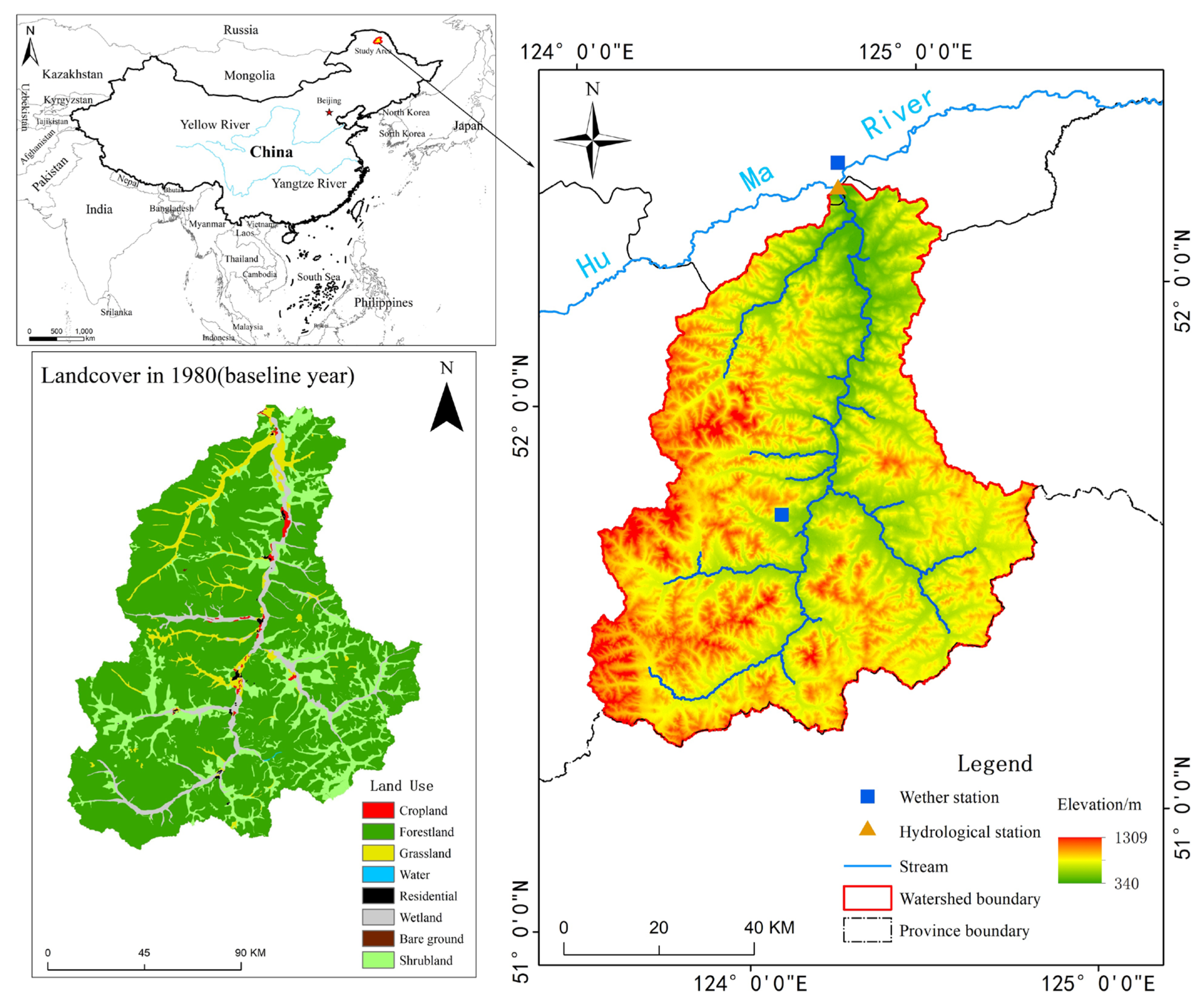
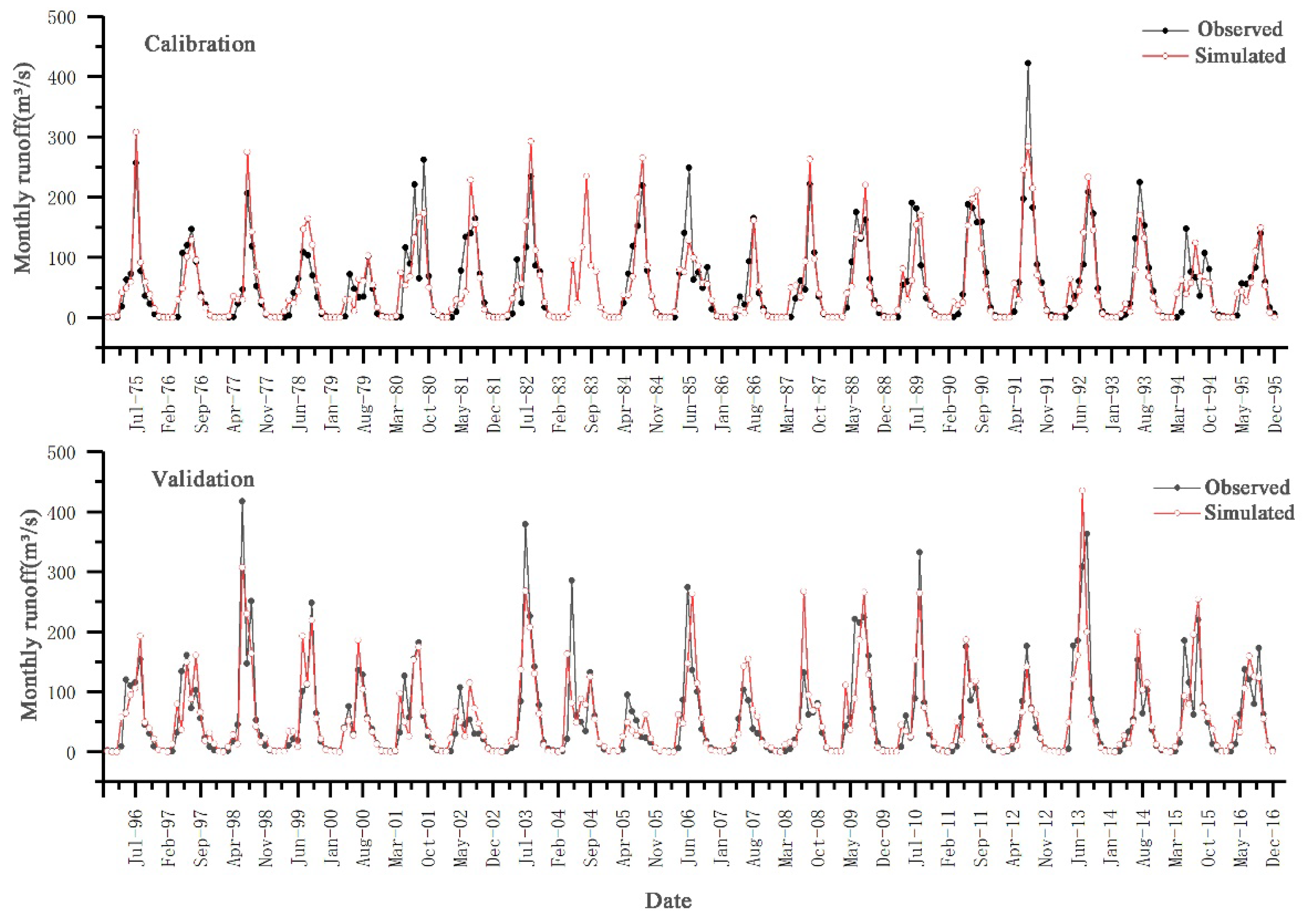

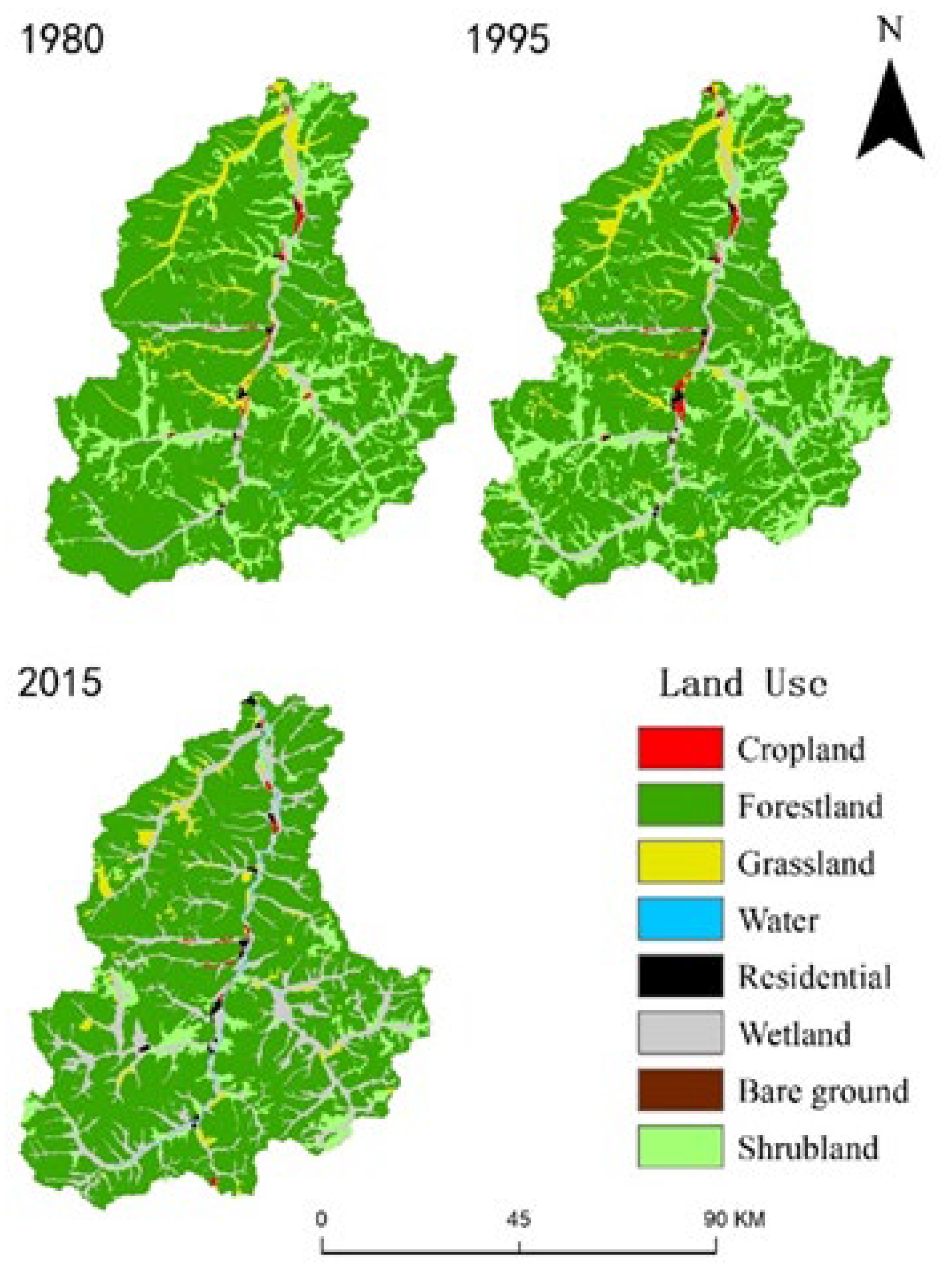
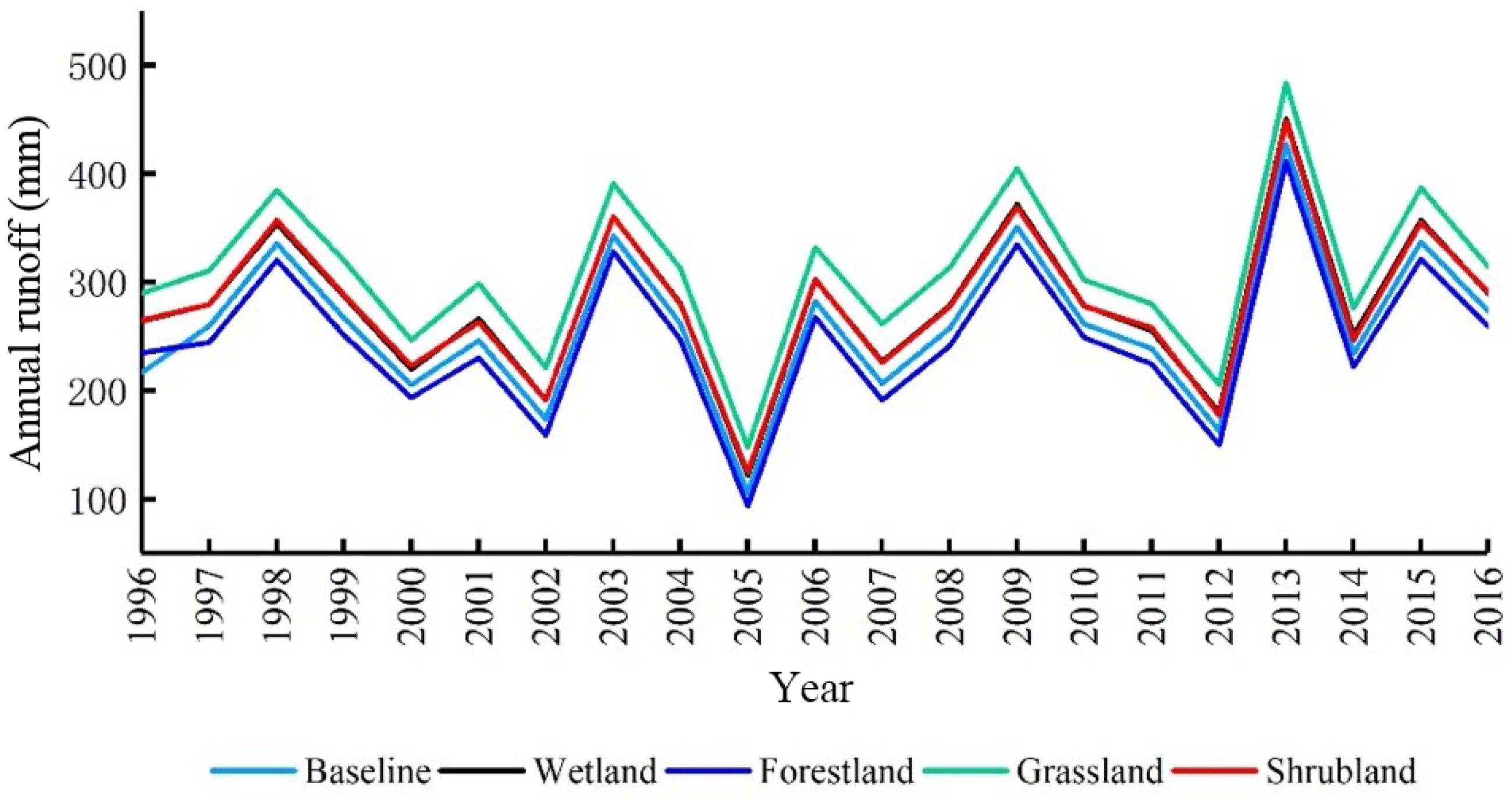
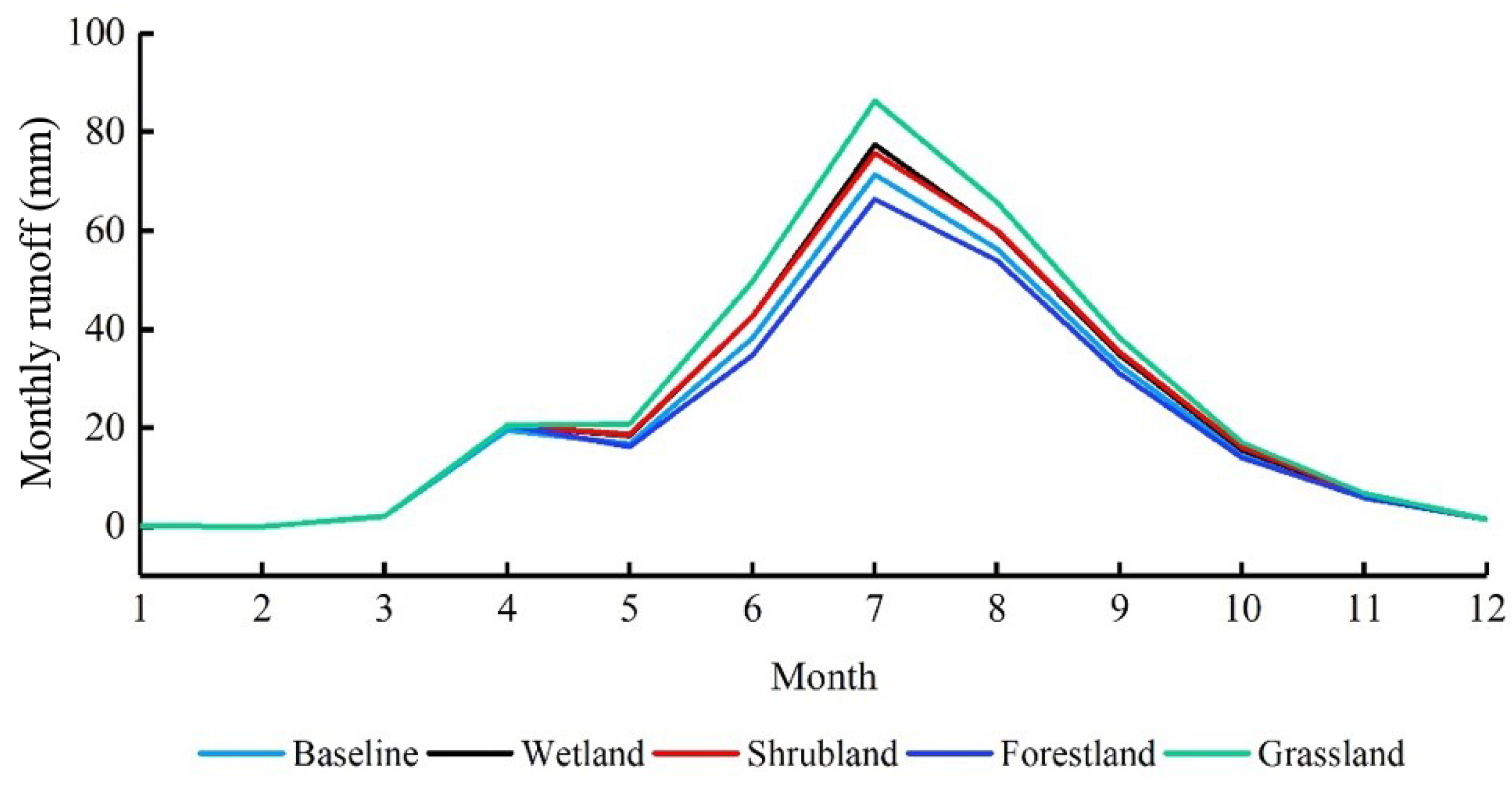
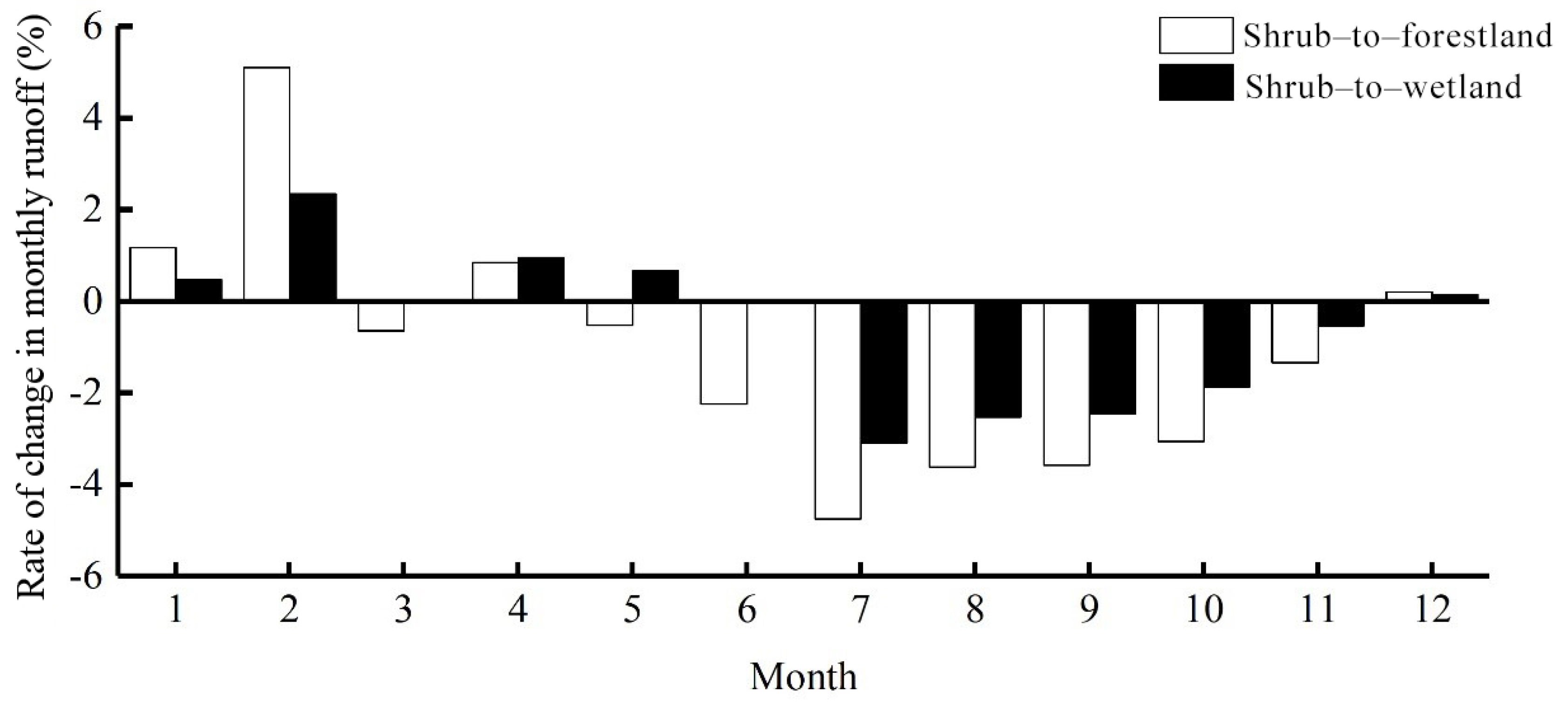
| Scenario | Land Use (Period) | Range of Climate Data | |
|---|---|---|---|
| historical | scenario 1 | (1980) | 1975–2016 |
| scenario 2 | (1995) | 1975–2016 | |
| scenario 3 | (2015) | 1975–2016 | |
| extreme | scenario 4 | slope < 10° is wetland; slope > 10° is forestland | 1996–2016 |
| scenario 5 | grassland | 1996–2016 | |
| scenario 6 | forestland | 1996–2016 | |
| scenario 7 | shrubland | 1996–2016 | |
| future | scenario 8 | shrubland to forestland | 1996–2016 |
| scenario 9 | shrubland to wetland | 1996–2016 | |
| Name | Sensitivity Ranking | Calibration Method | Minimum | Maximum | Best Value |
|---|---|---|---|---|---|
| CN2 | 1 | R | −1.0 | 1.0 | 0.5920 |
| ALPHA_BNK | 2 | V | 0.0 | 1.0 | 0.2958 |
| ESCO | 3 | V | 0.0 | 1.0 | 0.7003 |
| SOL_AWC | 4 | R | −0.5 | 0.5 | −0.3520 |
| GW_DELAY | 5 | V | 0.0 | 500.0 | 499.2500 |
| ALPHA_BF | 6 | V | 0.0 | 1.0 | 0.9895 |
| HRU_SLP | 7 | R | −0.5 | 0.5 | 0.0037 |
| GWQMN | 8 | V | 0.0 | 1000.0 | 42.2500 |
| CH_K2 | 9 | V | 5.0 | 150.0 | 148.4250 |
| SOL_K | 10 | R | −0.24 | 0.25 | −0.0857 |
| NSE | R2 | PBIAS | Streamflow/(m3/s) | ||
|---|---|---|---|---|---|
| Observed | Simulated | ||||
| calibration | 0.78 | 0.79 | −0.1 | 49.03 | 49.08 |
| validation | 0.72 | 0.74 | −1.9 | 52.67 | 53.68 |
| Land Use Type | 1980 | 1995 | 2015 | Change from 1980–1995 (km2) | Change from 1995–2015 (km2) | |||
|---|---|---|---|---|---|---|---|---|
| Area (km2) | Proportion (%) | Area (km2) | Proportion (%) | Area (km2) | Proportion (%) | |||
| cropland | 23.45 | 0.36 | 37.18 | 0.56 | 19.44 | 0.30 | 13.73 | −17.74 |
| forestland | 5030.51 | 76.43 | 4636.16 | 70.44 | 4874.58 | 74.06 | −394.36 | 238.43 |
| shrubland | 951.11 | 14.45 | 1312.00 | 19.93 | 352.68 | 5.36 | 360.89 | −959.32 |
| grassland | 272.47 | 4.14 | 286.71 | 4.36 | 144.70 | 2.20 | 14.23 | −142.00 |
| water | 1.34 | 0.02 | 1.50 | 0.02 | 23.30 | 0.35 | 0.16 | 21.80 |
| residential | 14.11 | 0.21 | 20.62 | 0.31 | 27.45 | 0.42 | 6.51 | 6.83 |
| wetland | 288.40 | 4.38 | 287.23 | 4.36 | 1139.70 | 17.32 | −1.17 | 852.46 |
| unused | 0.46 | 0.01 | 0.46 | 0.01 | 0.00 | 0.00 | 0.00 | −0.46 |
| Land Use Period | Mean Annual Runoff (mm) | Change in Runoff (mm) | Rate of Change Rate (%) |
|---|---|---|---|
| 1980 | 249.87 | — | — |
| 1995 | 255.08 | 5.2 | 2.08 |
| 2015 | 261.87 | 11.99 | 4.80 |
| Land Use (Period) | Mean Annual Runoff (mm) | Change in Runoff (mm) | Rate of Change Rate (%) |
|---|---|---|---|
| (2015) | 267.49 | — | — |
| shrub to forestland | 259.30 | −8.19 | −3.06 |
| shrub to wetland | 262.90 | −4.58 | −1.71 |
Publisher’s Note: MDPI stays neutral with regard to jurisdictional claims in published maps and institutional affiliations. |
© 2021 by the authors. Licensee MDPI, Basel, Switzerland. This article is an open access article distributed under the terms and conditions of the Creative Commons Attribution (CC BY) license (https://creativecommons.org/licenses/by/4.0/).
Share and Cite
Hu, P.; Cai, T.; Sui, F.; Duan, L.; Man, X.; Cui, X. Response of Runoff to Extreme Land Use Change in the Permafrost Region of Northeastern China. Forests 2021, 12, 1021. https://doi.org/10.3390/f12081021
Hu P, Cai T, Sui F, Duan L, Man X, Cui X. Response of Runoff to Extreme Land Use Change in the Permafrost Region of Northeastern China. Forests. 2021; 12(8):1021. https://doi.org/10.3390/f12081021
Chicago/Turabian StyleHu, Peng, Tijiu Cai, Fengxiang Sui, Liangliang Duan, Xiuling Man, and Xueqing Cui. 2021. "Response of Runoff to Extreme Land Use Change in the Permafrost Region of Northeastern China" Forests 12, no. 8: 1021. https://doi.org/10.3390/f12081021
APA StyleHu, P., Cai, T., Sui, F., Duan, L., Man, X., & Cui, X. (2021). Response of Runoff to Extreme Land Use Change in the Permafrost Region of Northeastern China. Forests, 12(8), 1021. https://doi.org/10.3390/f12081021






